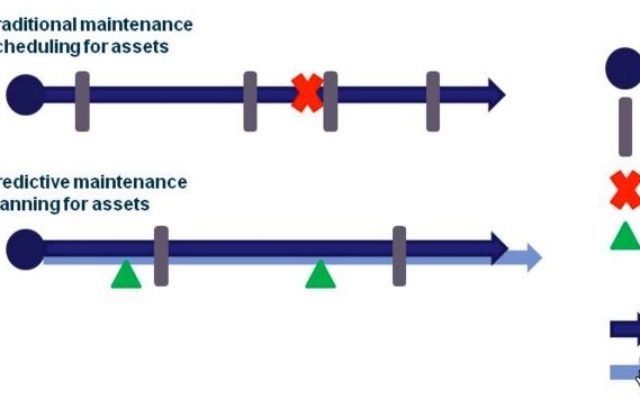Again today in the news is another Oil & Gas company posting a profit loss, a rig operator scrapping two rigs and predictions of shortfalls in supplies by 2020, plus major retrenchments of staff across the globe. With all of this going on the signs are that we are going to have to sweat the assets and do more with less. How then are we going to do more with less?
This post is going to focus on the use of Predictive Analytics for the Maintenance Process or PdM (Predictive Maintenance ) Organisation’s are looking at their operations and how to reduce costs more than ever before. They are experiencing increased consumer empowerment, global supply chains, ageing assets, raw material price volatility, increased compliance, and an ageing workforce. A huge opportunity for many organisations is a focus on their assets.
Although organisations lack not only visibility but also predictability into their assets’ health and performance, maximising asset productivity and ensuring that the associated processes are as efficient as possible are key aspects for organisations striving to gain strong financial returns.
In order for your physical asset to be productive, it has to be up, running, and functioning properly. Maintenance is a necessary evil that directly affects the bottom line. If the asset fails or doesn’t work properly, it takes a lot of time, effort, and money to get it back up and running. If the asset is down, you can’t use it. For example, you can’t manufacture products, mine for minerals, drill for oil, refine lubricants, process gas, generate power etc, etc.
Maintenance has evolved with the technology, organisational processes, and the times. Predictive maintenance (PdM), technology, has become more popular and mainstream for organisations, but in many cases remains inconsistent.
There are many reasons for the this that include the items below:
Availability of large amounts of data due to Instruments and connected assets (IoT)
Increased coupling of technology within businesses (MDM, ECM, SCADA)
Requirements to do more with less. For example, stretching the useful life of an asset (EOR)
Relative ease of use of garnering insights from raw data (SAP HANA)
Reduced cost of computing, network, and storage technology (Cloud Storage, SaaS, In Memory Computing)
Convergence of Information Technology with Operational technology (EAM, ECM)
PdM will assist organisations with key insights regarding asset failure and product quality, enabling them to optimise their assets, processes, and employees. Organisations are realising the value of PdM and how it can be a competitive advantage. Given the economic climate and pressure on everyone to do more with less.
Operations budgets are always the first to be cut, it no longer makes sense to employ a wait-for-it-to-break mentality. Executives say that the biggest impact on operations is failure of critical assets. In this post I am going to show how Predictive Analytics or PdM will assist organisations.
Predictive Maintenance Definition.
We have all understood what Preventive Maintenance was, it was popular in the 20th Century but PdM is very much focused in the 21st Century. PdM is an approach based upon various types of information that allows maintenance, quality and operational decision makers to predict when an asset needs maintenance. There is a myth that PdM is focused purely on asset data, however it is much more. It includes information from the surrounding environment in which the asset operates and the associated processes and resources that react with the asset.
PdM leverages various Analytical techniques to provide better visibility of the asset to the decision makers and analyses various type of data. It is important to understand the data that is being analysed. PdM is usually based upon usage and wear characteristics of the asset, as well as other asset condition information. As we know data comes in many different formats. The data can be at REST (data that is fixed and does not move over time) or Streaming data (where data can be constantly on the move).
Types of Data.
From my previous posts on the subject of Big Data you will know by now that there are basically two types of Data, however in the 21st century there is a third. The 1st being Structured Data, the 2nd being Unstructured data and the 3rd is Streaming Data. The most common of course is structured and is collected from various systems and processes. CRM, ERP, Industrial controls systems such as SCADA, HR, Financial, information and data warehouses etc. All of these systems contain datasets in tables. Examples of this include Inventory information, production information, financial information and specifically asset information such as name, location, history, usage, type etc.
Unstructured Data comes in the form of Text data such as e-mails, maintenance and operator logs, social media data, and other free-form data that is available today in limitless quantities is unstructured data. Most organisations are still trying to fathom how to utilise this data. To accommodate this data, a text analytics program must be in place to make the content useable.
Streaming data is information that needs to be collected and analysed in real time. It includes information from sensors, satellites, Drones and programmable logic controllers (PLCs), which are digital computers used for automation of electromechanical processes, such as control of machinery on factory assembly lines, amusement rides, or light fixtures. Examples of streaming data include telematic, measurement, and weather information this format is currently gaining the most traction as the need for quick decision making grows.
Why use PdM?
There are a number of major reasons to employ PdM and there is a growing recognition that the ability to predict asset failure has great long term value to the organisation.
Optimise maintenance intervals
Minimise unplanned downtime
Uncover in depth root cause analysis of failures
Enhance equipment and process diagnostics capabilities
Determine optimum corrective action procedures
Many Industries Benefit from PdM
For PdM to be of benefit to organisations, the assets must have information about them as well as around them. Here are a couple of examples from my own recent history. However any industry that has access to instrumented streaming data has the ability to deploy PdM.
Energy Provider
Keeping the lights on for an entire State in Australia is no small feat. Complex equipment, volatile demand, unpredictable weather, plus other factors can combine in unexpected ways to cause power outages. An energy provider used PdM to understand when and why outages occurred so it could take steps to prevent them. Streaming meter data helped the provider analyze enormous volumes of historical data to uncover usage patterns. PdM helped define the parameters of normal operation for any given time of day, day of the week, holiday, or season and detected anomalies that signal a potential failure.
Historical patterns showed that multiple factors in combination increased the likelihood of an outage. When national events caused a spike in energy demand and certain turbines were nearing the end of their life cycle, there was a higher likelihood of an outage. This foresight helped the company take immediate action to avoid an imminent outage and schedule maintenance for long-term prevention. With PdM, this energy provider
Reduced costs by up to 20 percent (based on similar previous cases) by avoiding the expensive process of reinitiating a power station after an outage
Predicted turbine failure 30 hours before occurrence, while previously only able to predict 30 minutes before failure
Saved approximately A$100,000 in combustion costs by preventing the malfunction of a turbine component
Increased the efficiency of maintenance schedules, costs and resources, resulting in fewer outages and higher customer satisfaction
Oil & Gas Exploration & Production Company
A large multinational company that explores and produces oil and gas conducts exploration in the Arctic Circle. Drilling locations are often remote, and landfall can be more than 100 miles away. Furthermore, the drilling season is short, typically between July and October.
The most considerable dangers that put people, platforms, and structures at risk are colliding with or being crushed by ice floes, which are flat expanses of moving ice that can measure up to six miles across. Should a particularly thick and large ice floe threaten a rig, companies typically have less than 72 hours to evacuate personnel and flush all pipelines to protect the environment. Although most rigs and structures are designed to withstand some ice-floe collisions, oil producers often deploy tugboats and icebreakers to manage the ice and protect their rigs and platform investments. This is easily warranted: a single oil rigcosts $350 million and has a life cycle that can span decades. To better safeguard its oil rigs, personnel, and resources, the company had to track the courses of thousands of moving potential hazards. The company utilised PdM by analyzing direction, speed, and size of floes using satellite imagery to detect, track, and forecast the floe trajectory. In doing so, the company
Saved roughly $300 million per season by reducing mobilisation costs associated with needing to drill a second well should the first well be damaged or evacuated
Saved $1 billion per production platform by easing design requirements, optimising rig placement, and improving ice management operations
Efficiently deployed icebreakers when and where they were needed most
Workforce Planning, Management & Logistics and PdM
The focus of predictive maintenance (PdM) is physical asset performance and failure and its associated processes. One key aspect that tends to be overlooked, but is critical to ensure PdM sustainability, is Human Resources. Every asset is managed, maintained, and run by an operator or employee. PdM enables organisations to ensure that they have the right employee or service contractor assigned to the right asset, at right time with the right skill set.
Many organisations already have enough information about employees either in their HR, ERP, or manufacturing databases. They just haven’t analysed the information in coordination with other data they may have access to.
Some typical types of operator information include
Name
Work duration
Previous asset experience
Training courses taken
Safety Courses
Licences
Previous asset failures and corrective actions taken
The benefits of using PdM in the WPML process include the following:
Workforce optimisation: Accurately allocate employee’s time and tasks within a workgroup, minimising costly overtime
Best employee on task: Ensure that the right employee is performing the most valuable tasks
Training effectiveness: Know which training will benefit the employee and the organisation
Safety: Maintain high standards of safety in the plant
Reduction in management time: Fewer management hours needed to plan and supervise employees
A more satisfied, stable workforce: Make people feel they are contributing to the good of the organisation and feel productive.
The key for asset intensive companies is to ensure that their assets are safe, reliable, and available to support their business. Companies have found that simply adding more people or scheduling more maintenance sessions doesn’t produce cost-effective results. In order for organisations to effectively utilize predictive maintenance (PdM), they must understand the analytical process, how it works, its underlying techniques, and its integration with existing operational processes; otherwise, the work to incorporate PdM in your organisation will be for nothing.
The Analytical Process, the three “A” approach.
As organisations find themselves with more data, fewer resources to manage them, and a lack of knowledge about how to quickly gain insight from the data, the need for PdM becomes evident.The world is more instrumented and interconnected, which yields a large amount of potentially useful data. Analytics transforms data to quickly create actionable insights that help organizations run their businesses more cost effectively
First A = Align
The align process is all about the data. You understand what data sources exist, where they are located, what additional data may be needed or can be acquired, and how the data is integrated or can be integrated into operational processes. With PdM, it doesn’t matter if your data is structured or unstructured, streaming or at rest. You just need to know which type it is so you can integrate and analyse the data appropriately.
Second A = Anticipate
In this phase, you leverage PdM to gain insights from your data. You can utilise several capabilities and technologies to analyse the data and predict outcomes:
1). Descriptive analytics provides simple summaries and observations about the data. Basic statistical analyses, for which most people utilise Microsoft Excel, are included in this category. For example, a manufacturing machine failed three times yesterday for a total downtime of one hour.
2). Data mining is the analysis of large quantities of data to extract previously unknown interesting patterns and dependencies. There are several key data mining techniques:
Anomaly detection: Discovers records and patterns that are outside the norm or unusual. This can also be called outlier, change, or deviation detection. For example, out of 100 components, component #23 and #47 have different sizes than the other 98.
Association rules: Searches for relationships, dependencies, links, or sequences between variables in the data. For example, a drill tends to fail when the ambient temperature is greater than 100 degrees Fahrenheit, it’s 1700 hrs, and it’s been functioning for more than 15 hours.
Clustering: Groups a set of objects in such a way that objects in the same group are more similar to each other than to those in other groups. For example, offshore oil platforms that are located in North America and Europe are grouped together because they tend to be surrounded by cooler air temperatures, while those in South America and Australia are grouped separately because they tend to be surrounded by warmer air temperatures.
Classification: Identifies which of a set of categories a new data point belongs to. For example, a turbine may be classified simply as “old” or “new.”
Regression: Estimates the relationships between variables and determines how much a variable changes when another variable is modified. For example, plant machinery tends to fail as the age of the asset increase.
Text mining derives insights and identifies patterns from text data via natural language processing, which enables the understanding of and alignment between computer and human languages. For example, from maintenance logs, you may determine that the operator always cleans the gasket in the morning before starting, which leads to an extended asset life.
Machine learning enables the software to learn from the data. For example, when an earthmover fails, there arethree or four factors that come into play. The next time those factors are evident, the software will predict that the earthmover will fail. You may come across predictive analytics. It is a category of analytics that utilises machine learning and data mining techniques to predict future outcomes.
Simulation enables what-if scenarios for a specific asset or process. For example, you may want to know how running the production line for 24 continuous hours will impact the likelihood of failure.
Prescriptive analytics goes beyond predicting future outcomes by also suggesting actions and showing the implications of each decision option. For example, based on the data, organisations can predict when a water pipe is likely to burst. Additionally, the municipality can have an automated decision where for certain pipes, certain valves must be replaced by a Level-3 technician. Such an output provides the operations professional with the predictive outcome, the action, and who needs to conduct the action. A decision management framework that aligns and optimises decisions based on analytics and organisational domain knowledge can automate prescriptive analytics.
The Final A = Act
In the final A, you want to act at the point of impact with confidence on the insights that your analysis provided. This is typically done by using a variety of channels including e-mail,mobile, reports, dashboards, Microsoft Excel, and enterprise asset management systems (EAM) essentially, however, your organisation makes decisions within your operational processes. A prominent aspect of the act phase is being able to view the insights from the anticipate process so employees can act on them. There are three common outputs:
Reports: Display results, usually in list format
Scorecards: Also known as balanced scorecards; automatically track the execution of staff activities and monitor the consequences arising from these actions; primarily utilised by management
Dashboards: Exhibit an organisation’s key performance indicators in a graphical format; primarily utilised by Senior Management
Organisations that utilise as many analytical capabilities ofPdM as possible will be able to optimise the appropriate analytics with the data. Ultimately, organisations will have better insights and make better decisions than those organisations that don’t. It may be easier for you to leverage a single software vendor that can provide all of these capabilities and integrate all three phases in your operational processes so you can maximise PdM’s benefits. Here are a few names to be going on with, TROBEXIS, OPENTEXT, SAP, MAXIMO
Article by channel:
Everything you need to know about Digital Transformation
The best articles, news and events direct to your inbox
Read more articles tagged: Featured, Predictive Analytics






